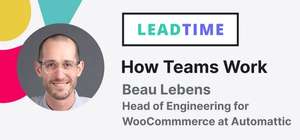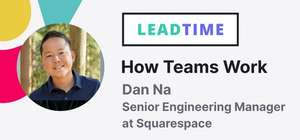Leading a team, especially a distributed or growing one, can be hard. Oftentimes the best advice and ideas come from other teams just like yours. That’s why we launched Lead Time: How Teams Work. This blog series profiles real teams, how they’re structured, and how they communicate through meetings and other touchpoints. Plus, each article features a top-notch leader who's got proven tips and real stories to learn from.
Meet Nic Roth, Head of Engineering at Postscript
Nic Roth leads the engineering team at Postscript — a fully remote company that helps Shopify sellers build relationships with customers via SMS.
The engineering, product, and design teams at Postscript are 70 people distributed across North America, working across different time zones and locations. They were fully remote before the pandemic and plan to stay that way. Working remotely is so foundational to the Postscript team that it’s even written into their mission statement.
We asked Nic to share his approach for leading a fully remote team and what he thinks makes it effective.
Here’s how Postscript’s remote-first product team operates
Within Nic’s org, folks work on sub-teams broken up by product or feature area. Each sub-team is led by an eng manager and most are cross-functional in nature — consisting of front-end engineers, full-stack or backend engineers, designers, and product managers.
Async-first communication culture
For the Engineering teams at Postscript, standing meetings only happen when absolutely necessary.
“We very much try to be asynchronous first — we use a lot of Slack and Loom and things like that,” explains Nic. �“We have a handful of meetings, but we really try to cut down on those as much as possible, mostly because coordinating across time zones and trying to really enable flexible work makes synchronous work difficult,” shares Nic.
“We're definitely not anti-meeting or anti-synchronous work,” he adds. “But we try to keep the recurring ones to a minimum.”
The team’s remote toolkit allows them to accomplish the same things an in-person eng team would — but asynchronously instead.
Weekly updates over Loom
To share progress without adding meetings to the mix, each sub-team sends out a weekly Loom to share what they accomplished. They might show work with a demo or talk through updates, challenges, and roadblocks. Folks rotate through who shares each week.
“It's incredibly helpful to be able to keep track of what’s happening asynchronously,” says Nic. “Having to do all that face-to-face would be really, really costly for us since we’re a relatively large group of people.”
Only the essential recurring meetings
Regular meetings are kept to a minimum to give the team more time to work independently. Three that still make the cut include:
- Bi-weekly company all-hands: The whole Postscript team comes together to talk through business updates and announcements, and share demos.
- Product team all-hands: This one happens every 2 weeks and focuses on more departmental-specific topics for eng, product, and design — like project planning or introducing new teammates. The group kicks off the meeting with a team-building question to strengthen bonds and get to know each other a bit better.
- Weekly sub-team meetings: These 30-minute meetings offer space for eng managers to pass down important updates to their team and the whole group to problem solve together. Nic leaves it up to his sub-teams to decide how often they’ll meet and says generally, most don’t have more than 1 or 2 standing synchronous sessions each week.
“We've definitely experimented a lot with a lot of these things,” shares Nic. “We've had some teams try to do more of a classic two weeks scrum model — with daily stand-ups, backlog grooming meetings, etc. We've seen mixed results. Usually, over time, those degrade to fewer synchronous meetings, which is where most of our teams have landed.”
Nic’s top remote work tip: Build in moments for connection
Though team bonding activities over video might feel cheesy or like a waste of time, Nic says they go a long way in building culture. Especially on a remote team where watercooler conversation is nonexistent.
“[If you’ve ever worked in an office], think about how many times you have casual conversation throughout the day,” says Nic. “Maybe you’re at your desks as a group and then get up and head to a conference room — you get to talk for that 90 seconds on the way. ‘How are you? How're the kids?’ We don’t get those moments for personal connection, so we have to intentionally build them in.”
One way the Postscript product team does this is by kicking off each team meeting with a team icebreaker question. They spend the first 5-10 minutes on it and do a mix of light, fun questions and deeper, personal topics.
For the deeper questions, the team will split into breakout rooms of 4-5 people to ensure discussion can happen but doesn’t cut too much into meeting time. For lighter questions (like “What’s your favorite ice cream flavor?”) the whole group stays together for a quick round-robin.
He adds, “I've had people say to me, ‘Wow, it seems like we waste a lot of time on icebreaker questions.’ I'm like, ‘Yeah, well that's kind of the point.’ If we’re not intentional about actually connecting with each other — outside of daily work — it’s never going to happen.”
Check out some of our favorite team-building icebreakers







